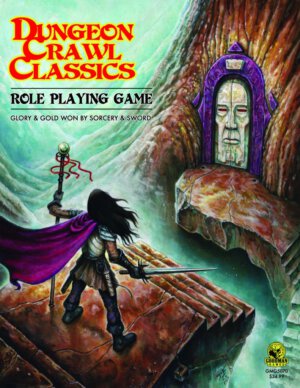
Publisher: Goodman Games
Designer: Joseph Goodman
Year: 2012
Players: Two or more
Ages: Guessing 12+
Playing Time: It’s an RPG so it could be forever!
Pages: 488
Genre: Retro Fantasy RPG
Retail Price: $39.99 hardcover book; $24.99 PDF
Dungeon Crawl Classics (DCC) by Goodman Games has received quite a bit of attention since its debut last year. DCC is an old school fantasy adventure with simple rules and interesting concepts based upon the Open Gaming License. My major gaming complaint has been my beloved AD&D evolved into a completely different animal than what I remembered; D&D used to be a great storytelling system with simple rules for combat and skills. It’s now this skirmish system where you need one or two rules lawyers on retainer to decipher the rules for min-max combat, while players not engaged in combat pass the time by building dice towers or checking Facebook on their cellphones. I know… I know… “Don’t hold back Dave, tell us how you really feel!”
But I digress… (deep breath)
So when I found out about DCC and read the book, I was overjoyed. One might even say I wiped away a tear of nostalgia. But of course I would deny it and comment on the dust content in the air at the time. In DCC, there’s enough crunch to keep it interesting but it all takes a backseat to story. And the book is a pleasure to leaf through as just about every one of its 488 pages contain wonderful black and white art reminiscent of old school fantasy. You’ll be hard pressed to find a page in this massive tome that doesn’t contain artwork.
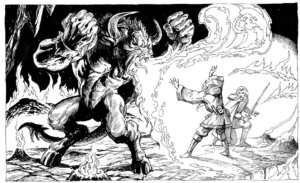
Ability scores are rolled using 3d6. No cheating folks. Whatever you roll is what you get. The abilities for each character are strength, agility, stamina, personality, intelligence, and luck. There’s no choosing the best rolls out of a certain number or assigning scores to attributes as you’d like; you get what you get.
Once zero level characters complete their combat rite of passage, they get to choose a class such as cleric, thief, warrior, wizard, dwarf, elf, or halfing. As you may have noticed, classes and races are one and the same. These seven classes are all which hare available. You don’t get to select race and class for your character; just one of these seven choices. Simple, huh?
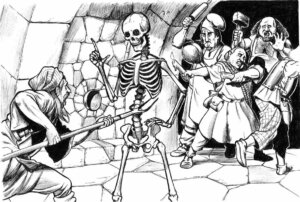
Let me tell you a little bit more about what makes this game special for me.
Warriors and dwarves get to perform a “mighty deed of arms” if they declare their deed and roll successfully. These are cinematic moves such as leaping onto a flying opponent and striking him down, spearing two enemies at once, taking out the eye of a dragon with a called shot, etc. I’m sure you get the picture (pun intended). So anything your imagination can come up with, you can do if you roll successfully.
Halfings are masters of two weapon fighting. Can you imagine Bilbo carrying two Stings? Halfings also are lucky and allow their luck to be used by those around them. I believe J.R.R. would be proud.
A natural roll of 1 is a fumble and a natural 20 is a critical hit. There is a multitude of tables displaying descriptive critical hits. For example, let’s say you’re a thief and roll a natural 20. You would then refer to the thief crit table and roll. If you rolled, say an 8, then you would have cut your foe’s face and he would be blinded by blood for 1d4 rounds. There are similar crit tables for all the classes.
Wizards, clerics, and elves all cast spells. Summoning magical energies is “arduous, expensive, and dangerous” and no spells are cast lightly. In the DCC world, no one would cast a spell just to light a torch. Each and every time a wizard rolls a natural 1 on a spell check, their spell fails and they may suffer corruption. Based on the corruption tables, a wizard very well could develop horrid pustules on his or her face, pass out, have their skin change to an unearthly shade, or any number of other grim possibilities. So again, if you want a torch lit, light it with flint and steel instead! Why take a chance?
Magic is mercurial. A spell cast by one wizard may be more or less powerful than one cast by his peer and it could take a different form. So for example, a fireball spell cast by one wizard might take the form of an actual fireball. The same spell cast by another wizard might be a stream of liquid flame. Also, the more powerful a wizard is, the more likely his spell will have stronger or more pronounced results.
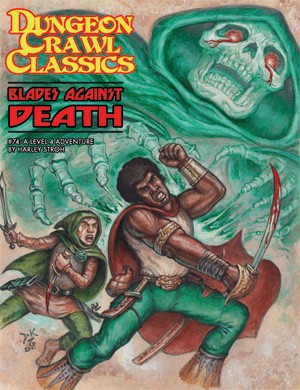
The last item I want to discuss is the rationale DCC presents for treasure. In most fantasy games, no thought is given to the vast hoards of treasure which most monsters hold. All it takes is a swing of your mighty sword to take the loot from these pitiful creatures and you’re loaded! Time to visit your local elven dealership for that warhorse, named Ferrari, you’ve had your eye on and upgrade your hovel to a multi-level castle – said castle on the nice side of the kingdom of course. You’ll certainly be moving away from those dirty peasants which used to be your neighbors. DCC encourages you to think about how much treasure is available for your heroes to find. “If there is easy access to vast wealth simply by setting off on a life of adventure, how do peasants remain mere serfs? Good question. Why farm when a few dangerous journeys can produce extraordinary wealth?” That’s another good question. Now, I’m not saying your heroes should risk their skin for a few paltry gold pieces but it makes more sense to construct the finding of treasure more reasonable and maybe, just maybe, not the only point of your fantasy quests? Just sayin’.
I really can’t say enough about DCC Classics as it’s quickly become one of my favorites! Goodman Games has supported the title with an incredible number of supplements and adventures (I believe 74 modules as of this writing) and outside companies are publishing material for the system as well. When it’s all said and done, if you’re looking for an excellent intertwining of roleplaying concepts both old and new, you certainly can’t go wrong with Dungeon Crawl Classics!



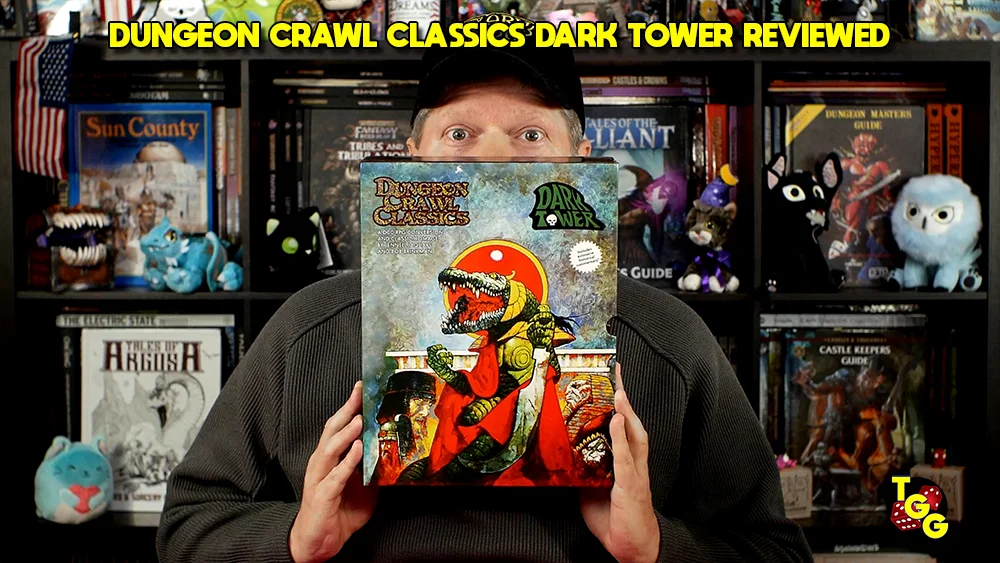






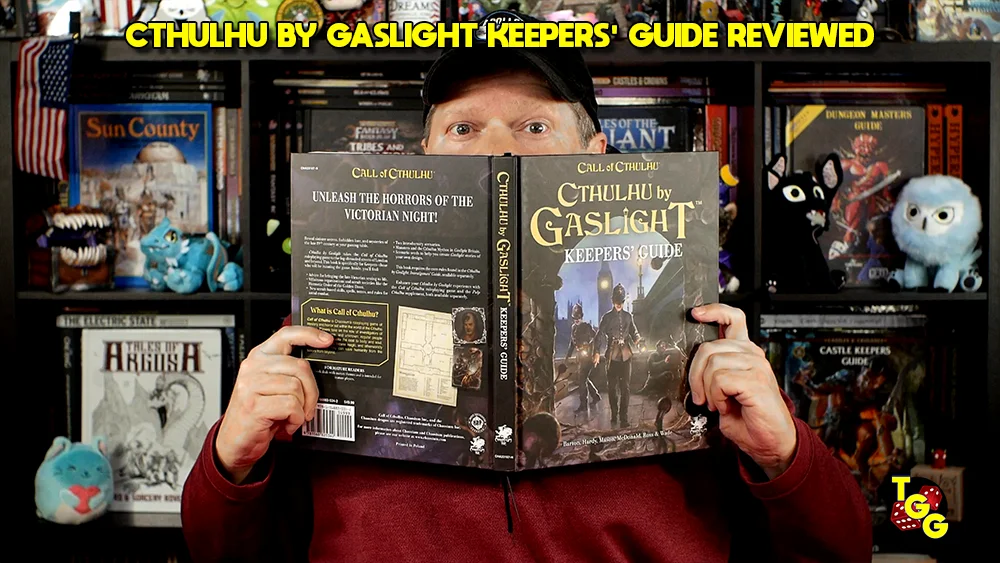








Nice review. I just picked up the pdf a couple days ago, and it’s awesome. Much like you once I started reading it I was instantly overcome with nostalgia.
I haven’t been this excited sine I discovered 1981, I was 7 and had no idea what was going on or what half the rules were, but it stuck and was a major part of my childhood. I feel DCC RPG hits the nail on the head and then some.
I’m 40 now, have read many of the authors listed in the N Appendix, and I must say while this game is a bit more fast and furious than slow and steady, not the best RPG for a long term campaign you would think. But I learned some things about philosophy. theology, HP Lovecraft, and other authors in the past 3 decades. I have come to the conclusion that DCC really leaves you inspired to build your own mythos, and give your world that flavor D & D may have taken.
I feel like I’m 7 again, only this time I know what I am doing…well sorta lol. DCC RPG was a great find and I enjoyed your review.
Also know you wrote this a while ago, but I wanted you to know some of us are reading it, and finding it very helpful.
Damn you, nostalgia! You always know right where to hit me!